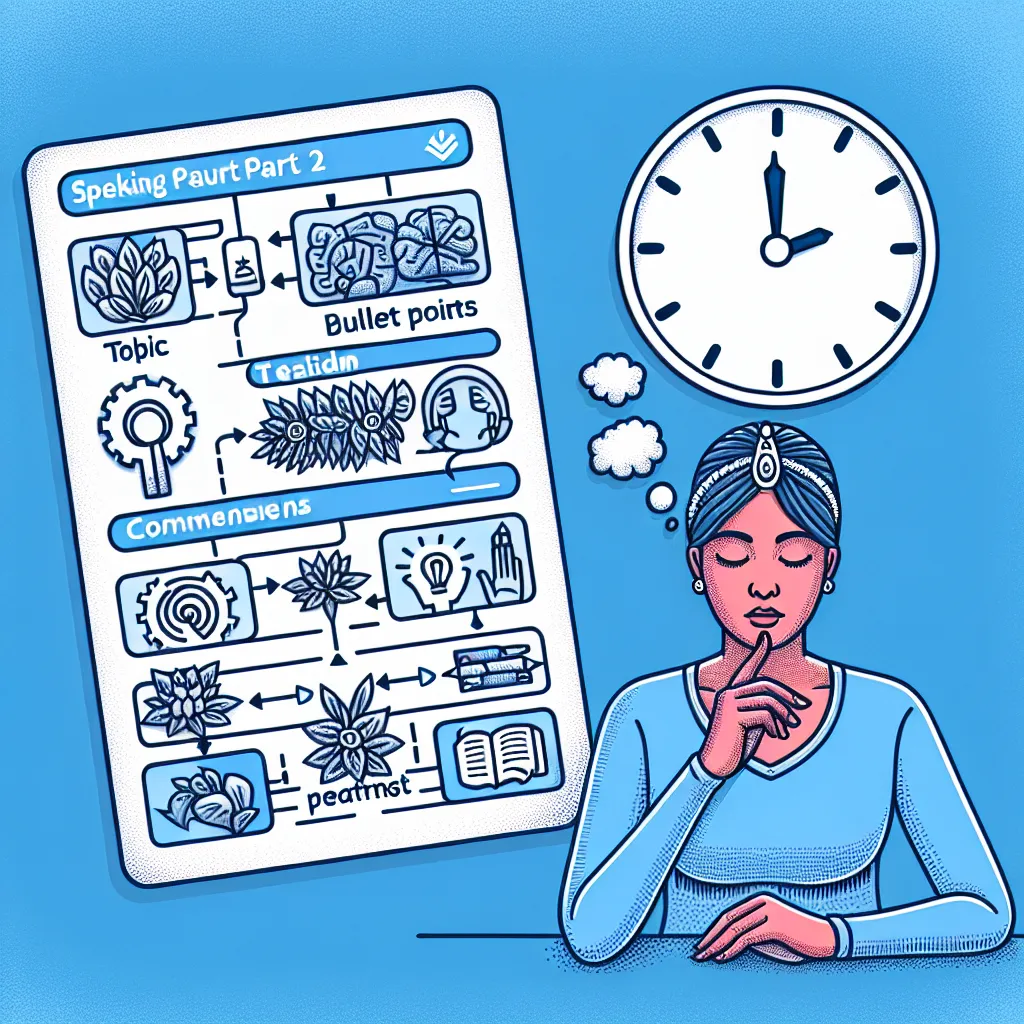Are you preparing for the IELTS exam and feeling anxious about the Speaking Part 2? You’re not alone! Many test-takers find this section particularly challenging. However, with the right strategies and preparation, you can excel in your cue card performance. In this comprehensive guide, we’ll explore the best tips for IELTS Speaking Part 2 to help you boost your confidence and achieve a higher band score.
Understanding IELTS Speaking Part 2
Before diving into the tips, let’s briefly review what IELTS Speaking Part 2 entails. This section, also known as the “long turn” or “cue card task,” requires you to speak for 1-2 minutes on a given topic. You’ll receive a task card with a subject and some prompts to guide your speech. You’ll have one minute to prepare before you start speaking.
 IELTS Speaking Part 2 Cue Card
IELTS Speaking Part 2 Cue Card
Essential Tips for IELTS Speaking Part 2 Success
1. Master the Art of Note-Taking
During your one-minute preparation time, jotting down key points is crucial. Here’s how to make the most of it:
- Use abbreviations and symbols to save time
- Focus on the main ideas related to the prompts
- Organize your notes in a logical sequence
Remember, your notes are just a guide. Don’t try to write full sentences; brief keywords are sufficient.
2. Structure Your Response
A well-structured answer can significantly improve your score. Follow this simple outline:
- Introduction: Rephrase the topic and briefly mention what you’ll talk about
- Main points: Address each prompt on the cue card
- Conclusion: Summarize or give a final thought on the topic
This structure helps you stay organized and ensures you cover all required points.
3. Use a Range of Vocabulary
Demonstrating a wide vocabulary is crucial for a high band score. Here are some strategies:
- Learn and use topic-specific vocabulary
- Incorporate idiomatic expressions naturally
- Use synonyms to avoid repetition
For example, instead of repeatedly saying “interesting,” you could use “fascinating,” “intriguing,” or “captivating.”
4. Practice Time Management
Speaking for the full two minutes without running out of things to say is a common challenge. Try these techniques:
- Use a stopwatch during practice sessions
- Elaborate on each point with examples or explanations
- If you finish early, add more details or personal opinions
Remember, it’s better to speak for the full time than to finish too quickly.
5. Develop Your Ideas
Examiners are looking for well-developed responses. To achieve this:
- Provide specific examples to support your points
- Share personal experiences related to the topic
- Explain the reasons behind your opinions
This approach demonstrates your ability to think critically and express yourself clearly.
6. Improve Your Fluency
Smooth, natural speech is a key factor in your score. Here’s how to enhance your fluency:
- Practice speaking on various topics regularly
- Use fillers and hesitation devices naturally (e.g., “Well,” “You see,” “Let me think”)
- Don’t worry about small mistakes; keep speaking confidently
Remember, fluency is about maintaining a steady flow of speech, not about speaking quickly.
7. Master Pronunciation and Intonation
Clear pronunciation and natural intonation can significantly impact your score. Try these techniques:
- Record yourself speaking and listen for areas of improvement
- Practice stress and intonation patterns of English
- Focus on commonly mispronounced words in your language
Pay attention to word stress, sentence stress, and the rise and fall of your voice.
8. Utilize the Entire Cue Card
Make sure to address all the prompts on the cue card. Some tips:
- Quickly scan all prompts during preparation time
- Mentally check off each point as you cover it
- If you forget a prompt, don’t panic – move on to the next one
Covering all prompts shows that you’ve understood and completed the task fully.
9. Be Prepared for Common Topics
While you can’t predict the exact topic, certain themes are common in IELTS Speaking Part 2. Prepare for topics like:
- Personal experiences
- Memorable events
- Favorite objects or places
- People you admire
- Future plans or aspirations
Having some ideas ready for these common themes can boost your confidence.
10. Stay Calm and Confident
Maintaining composure is crucial for a good performance. Here are some tips:
- Take deep breaths before and during your preparation time
- Remind yourself of your preparation and abilities
- Speak with a confident tone, even if you’re feeling nervous
Remember, the examiner wants you to do well and is there to assess, not to judge you.
Next Steps: Practice and Feedback
Now that you’re armed with these tips, it’s time to put them into practice. Here’s what you can do:
- Find sample cue cards online or in IELTS preparation books
- Practice speaking on these topics, recording yourself if possible
- Review your recordings or get feedback from a teacher or study partner
- Identify areas for improvement and focus on them in your next practice session
Remember, consistent practice is key to improving your IELTS Speaking Part 2 performance.
In conclusion, mastering IELTS Speaking Part 2 requires a combination of strategic preparation, effective time management, and confident delivery. By implementing these tips and practicing regularly, you’ll be well-equipped to tackle any cue card topic that comes your way. Stay focused, remain calm, and let your personality shine through in your responses. Good luck with your IELTS journey!
[internal_links]
- Mastering IELTS Listening: Top Strategies for Success
- IELTS Writing Task 2: A Step-by-Step Guide to High Scores
- Essential IELTS Vocabulary: Boost Your Band Score
[/internal_links]




